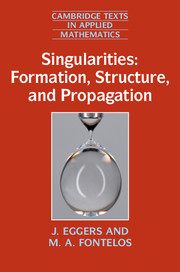Preface
Published online by Cambridge University Press: 05 September 2015
Summary
The word “singularity” is used popularly to describe exceptional events at which something changes radically or where a new structure emerges. In the mathematical language of this book, we speak of a singularity when some quantity goes to infinity. This is usually related to the solution of a differential equation which loses smoothness in that either the unknown itself or its derivatives become unbounded at some point or region of their domain.
Very often a singularity understood in the strict mathematical sense justifies the popular use of the word, since it represents a situation or structure of special interest. For example, a singularity of the curvature lies at the center of a black hole, which is formed after the collapse of a supermassive star, and the universe itself is generally believed to have begun at a singularity. Unfortunately, the real difficulty here lies with the correct physical interpretation of the mathematical solution, which is the reason we have not been able to include examples from general relativity.
Examples of singularities discussed in this book are vortices, such as the flow around the center of a tornado, shock waves generated by the motion of a supersonic plane, caustic lines of intense brightness produced by the focusing of light, and the formation of a drop that results from the discontinuous separation of a liquid mass into two or several pieces.
Starting in the nineteenth century with the study of shock waves, singularities have been investigated on an individual basis. They have remained one of the most exciting research topics in both pure and applied mathematics. For example, two of the seven Millennium Prize problems, proposed by the Clay Foundation, were directly or indirectly related to singularities. The sixth problem was to investigate whether the Navier–Stokes equation, which describes the motion of fluids, does or does not produce any singularities. A related and hotly debated problem poses the same question for the Euler equation, which is the Navier–Stokes equation in the absence of viscosity. Both problems are still to be solved.
The third Millennium Problem, known as the Poincaré conjecture, was solved by G. Y. Perelman while studying the singularities of the partial differential equation describing Ricci flow (similar equations will be studied in Chapter 9 of this book).
- Type
- Chapter
- Information
- Singularities: Formation, Structure, and Propagation , pp. xiii - xviPublisher: Cambridge University PressPrint publication year: 2015

